Planning to visit Bogotá? Want to know what to do and see in Colombia’s capital? Here are our recommendations for 10 of the best things to do in Bogotá for a taste of the city’s vibrant culture, history and food.
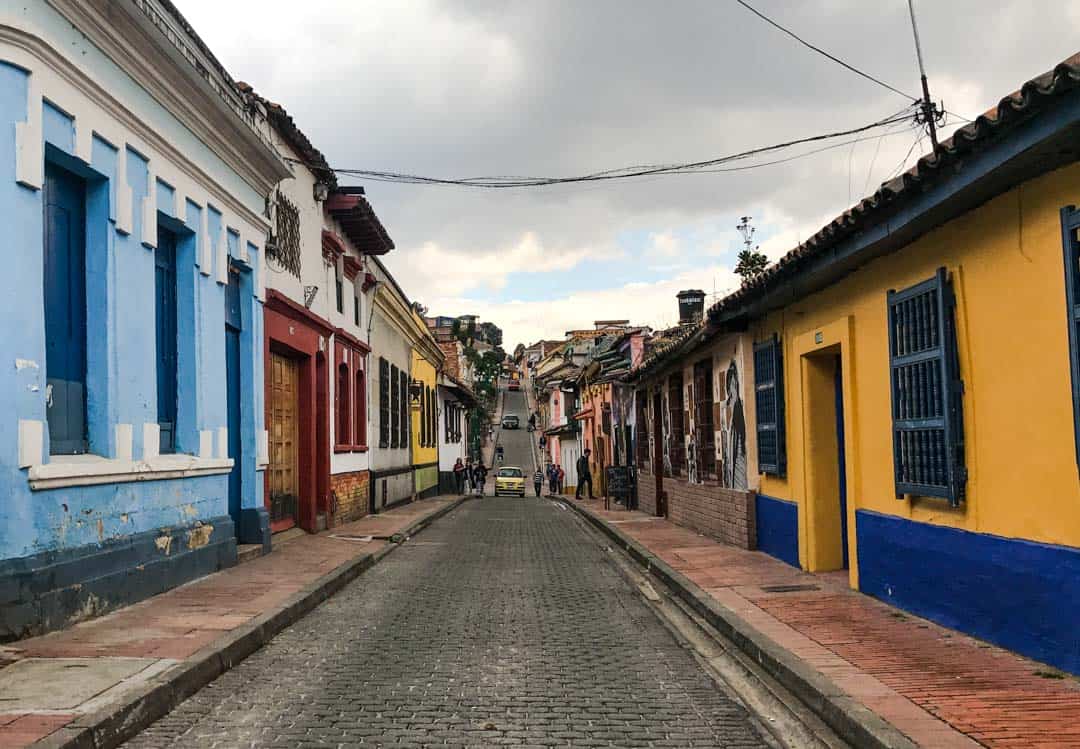
Sprawling over a high plateau in central Colombia, Bogotá is a bustling, vibrant metropolis with a story as rugged as the mountains surrounding it.
People have been living the high-altitude life here for thousands of years, but it’s the turmoils of the more recent past that have left the city with a gritty reputation that lingers on. These days though, the city is stepping out from its shadows.
To visit Bogotá is to get beyond the perceptions of the outside world and build your own memories through personal experience with the city’s rich culture, history and flavours. We weren’t sure what to expect, but our four days there were a highlight of our last minute trip to Colombia.
Whether you’ve got a day or a week, we’ve compiled our top things to do in Bogotá so you can make the most of your time in this vibrant and engaging mountain capital.
Get to know the city on a free Bogotá walking tour
One of the very first things we do whenever we arrive in a new city these days is search out a guided walking tour.
In our experience, this is a sure-fire way to get your bearings and develop a sense of a city fast: you’ll save a ton of time having someone else show you what and where Bogotá’s highlights are, but more importantly, you’ll get a first-hand, local insight into the history, culture, traditions and quirks – the good stuff as well as the darker aspects – that give this city its heart and character.
In Bogotá, we signed up with Beyond Colombia for their awesome 3-hour free walking tour around the city’s cultural and historic heart, La Candelaria.
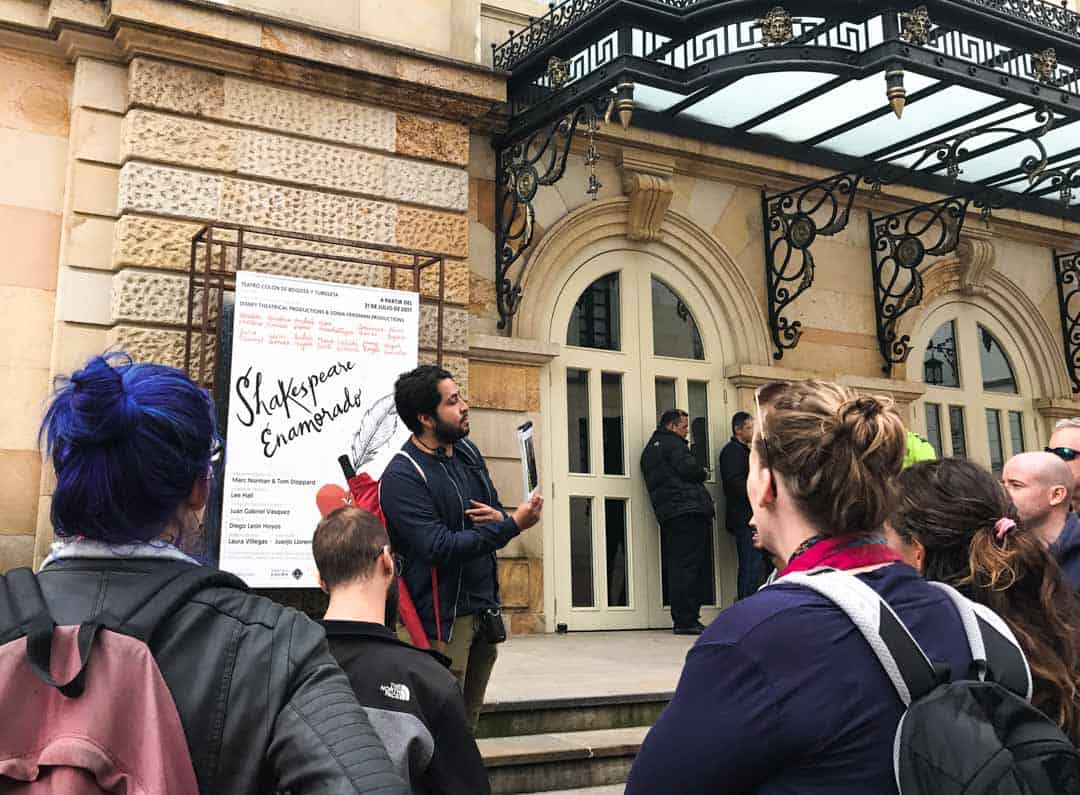
Throughout the tour, our guide regaled us with tales of the past, personalities, high points, lowlights and cultural idiosyncracies that weave together the story of Bogotá, and Colombia more broadly.
We heard about Bogotá’s beginnings, and how natural resources like gold and emeralds, as well as people and movements like Jorge Eliécer Gaitán, Pablo Escobar and FARC, have impacted and shaped the country.
We stopped by some of the city’s best known attractions, like the Botero Gallery and Plaza Bolívar. But we also visited some of La Candelaria’s more local haunts, like Calle del Empudo (we cover this quirky little street further on).
We also stopped to sample Colombian goodies along the way, like the local snack oblea, spicy cinnamon hot chocolate, and the opinion-dividing fermented drink, chicha.
By the end of the tour, we were in a much better position to plot the rest of our stay in Bogotá, and we were armed with a bunch of tips from our guide on the best places to eat and drink around the city. Plus, we left with an invaluable glimpse into who Bogotanos are today, where they’ve come from, and how they’re shaping their future.
Is it really a ‘free’ tour? Donation tours, usually billed as ‘free’ tours, are becoming a popular model in cities the world over. Essentially, guides work on a donation basis rather than receiving a salary; at the end of the tour, you tip them what you think the tour was worth.
How you roll when it comes to tipping is totally your call but donation tour guides are doing a job and they rely on the tips they make. If you have a good time and your guide is great, just remember even a small tip can go a long way.
Wander Plaza Bolívar, Bogotá’s historic and civic heart
Since its founding by Spanish conquistadors in 1538, Bogotá’s civic life has centred on Plaza Bolívar, an expansive public square overshadowed by Mount Monserrate. Even before the arrival of Europeans though, this spot is believed to have held astronomical significance for the Indigenous Muisca people.
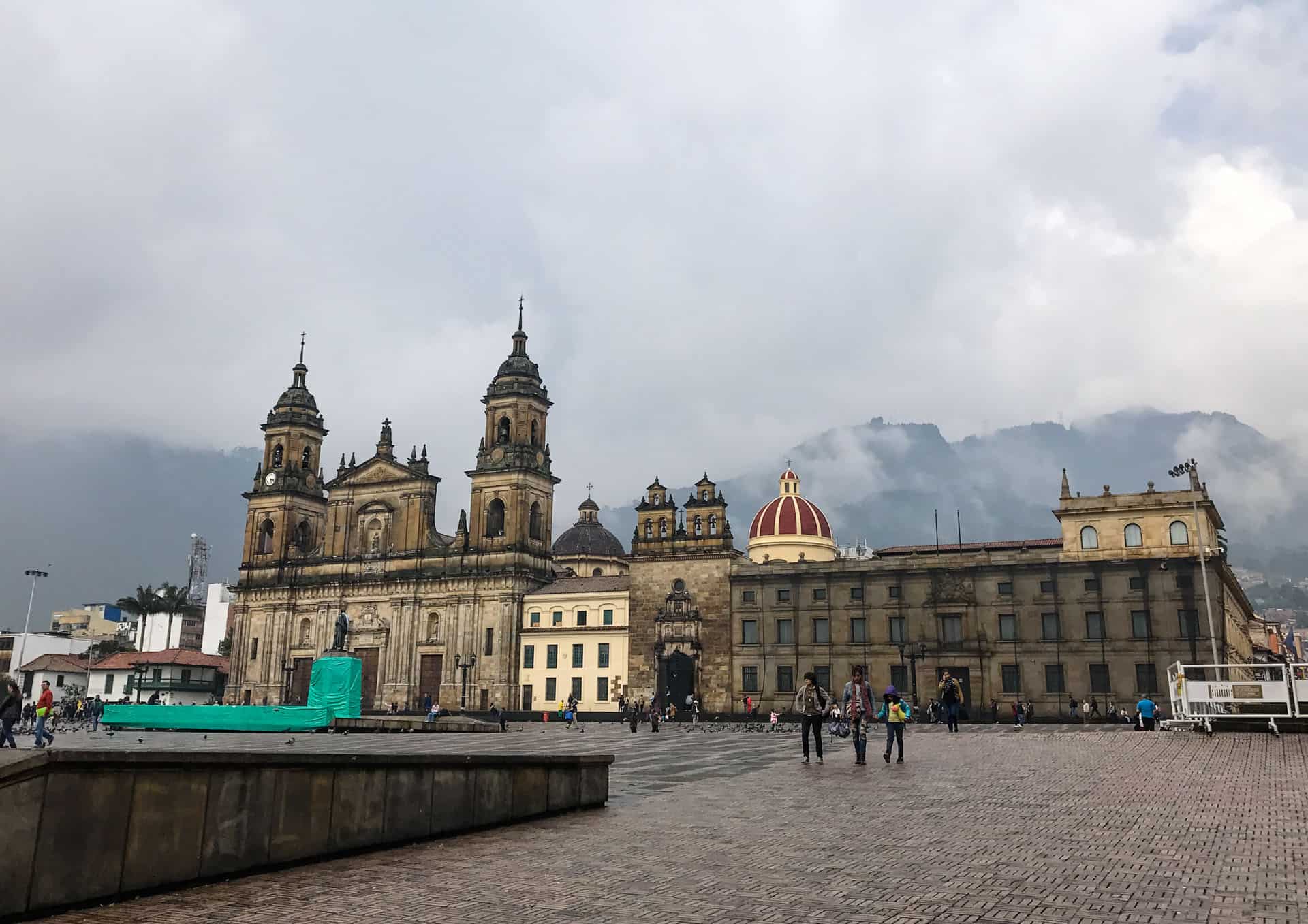
Today, pigeons might outnumber the people on this vast concrete-and-brick plaza, but the grand buildings lining the square make this a popular Bogotá attraction.
Plaza Bolívar was established as a market square and gathering place for the new city’s colonial residents in the 16th-century; even bullfights were held there until the late 17th-century.
Despite its long colonial past however, the perils of time, riots, terrorism and political instability mean that most of the buildings lining the square today date from more recent times.
In fact, the oldest building on Plaza Bolívar is the domed San Bartolomé high school in the south-eastern corner, which was built by Jesuits in 1604.
On the east side of the square, you’ll find the 19th-century Primatial Cathedral of Bogotá and the 17th-century holy chapel. On the west side, the long, many-windowed French-style building is the Mayor’s office, Liévano Palace. At the southern end, the imposing columned building is where Colombia’s Parliament sits.
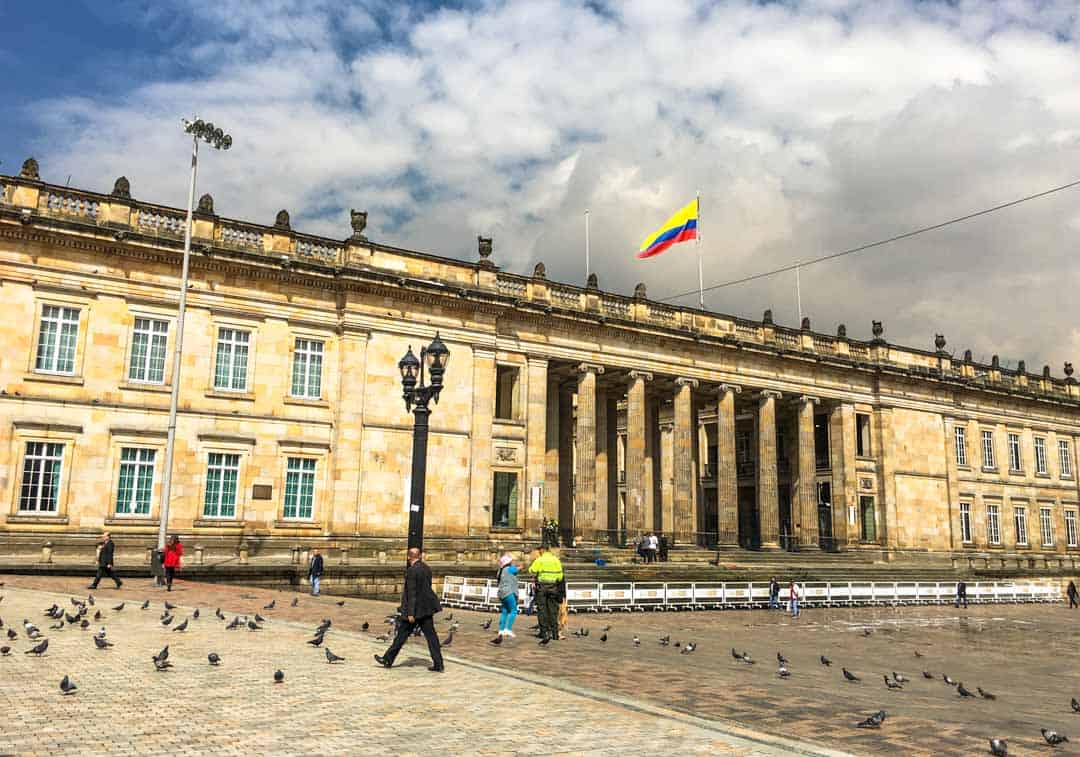
Perhaps the most intriguing building on Plaza Bolívar though is the squat, blockish modern construction on the north side. This is the Palace of Justice and if you’ve watched the Netflix series Narcos, you’ll know this as the site that guerilla group M-19 raided in 1985, in an attempt to get rid of evidence against Pablo Escobar.
The palace was destroyed during the 1985 siege, and twelve Supreme Court justices were killed. The building you see today was constructed thirteen years later. It wasn’t the first time the palace had been ruined either: the original justice building was burnt down in the riots of 1948. Third time’s a charm?
The watchers of the square: There are two statues to look out for in Plaza Bolívar. One is the square’s namesake: Simon Bolívar, a leader in the 19th-century South American independence revolution against Spain. He stands tall and toga’d in the centre of the square.
The other is less obvious, but also maintains a timeless watch over the plaza, albeit from a higher position. See if you can spot him.
Marvel at the glittering galleries of Bogotá’s Museum of Gold
If you sign up to the Beyond Bogotá walking tour we did, you’ll meet your guide outside the city’s most renowned gallery, the Museo del Oro (Museum of Gold). Whatever else you do, make a point to spend a couple of hours in this literal treasure chest: it’s one of the best things to do in Bogotá, if not the whole country.
The astonishing gold and silver riches of South America’s pre-Hispanic cultures were a tragic trigger for the waves of Spanish conquest that went on to plunder and destroy the region from the 16th-century.
In the north of Colombia, the city of Cartagena became the Spanish gateway to the continent, and the port through which much of the glittering cultural heritage of South America’s ancient civilisations was melted down and shipped away.
Fortunately, not everything was lost or smelted, and the Museo del Oro is one place where you can glimpse the people and the cultures of Colombia’s past through their exquisite handcrafted metalwork.
The museum’s collection encompasses some 55,000 artefacts of gold, pottery, stone, textiles and other materials. You can wander two floors showcasing a selection of the shiny exhibits, which are organised around cultural groups on one level, and ceremonial displays on the next.
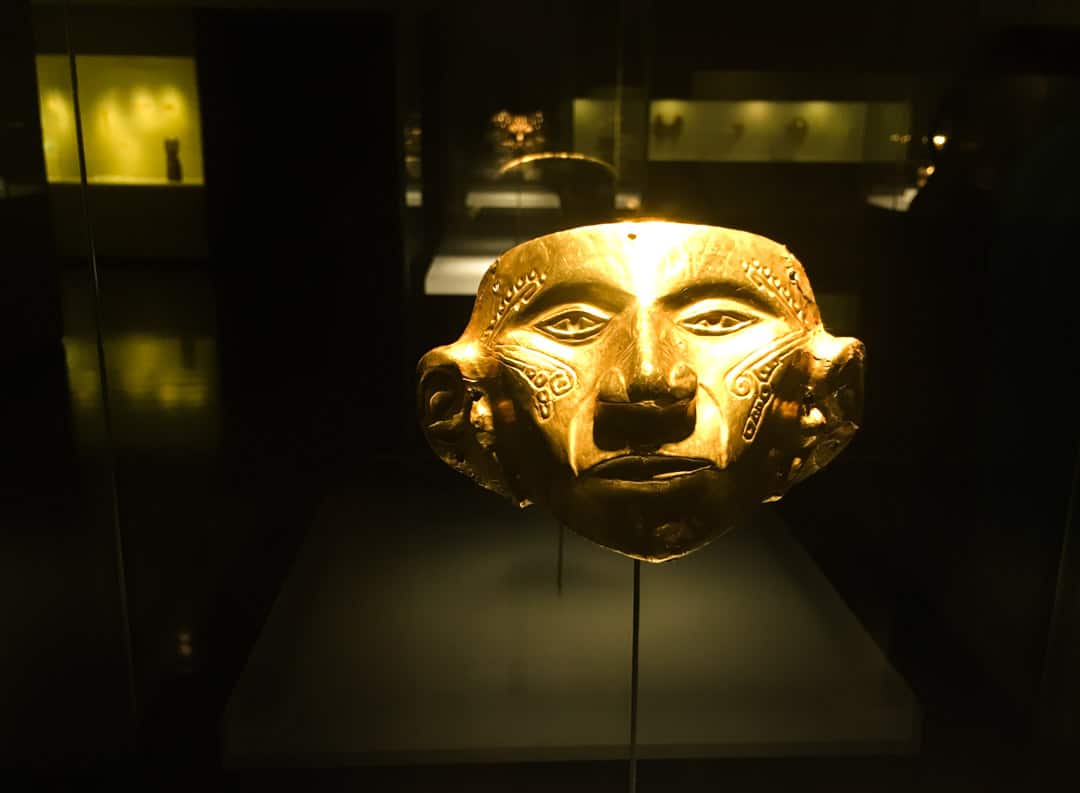
Each piece in the museum tells a story, and while you’ll find descriptions in English and Spanish on most items, and audioguides are also available, it’s worthwhile aligning your visit with one of the free hour-long tours run by the museum for a more in-depth intro to this golden hoard.
The Museum of Gold is open every day but Monday, and can be found on the corner of Parque de Santander in the centre of Bogotá.
Legendary gold: If there’s one piece in the Museo del Oro not to miss, it’s the ‘Muisca Raft’. This tiny yet masterful golden piece was found in a cave in a Colombian village in 1969.
It represents the ceremonial inauguration of the chief of the Muisca civilisation (whose territory included Bogotá). In the ritual, the new chief would be coated head to toe in gold dust and make offerings of gold and jewels to the gods from a raft on Lake Guatavita.
The gilded ceremony is thought to have been the inspiration for El Dorado, the legend that subsequently lured thousands to the Americas in search of a fabled lost city of gold.
Explore the colours and characters of La Candelaria
If you’re planning any kind of Bogotá sightseeing, chances are you’ll find yourself in La Candelaria, the lively neighbourhood at the city’s heart.
La Candelaria is an eclectic combination of old and new: many of the buildings date from the colonial-era but this is also the city’s modern downtown, and home to many of Bogotá’s highlight attractions, from Plaza Bolívar to the Gold Museum.
Exploring La Candelaria takes you from concrete jungle to vividly painted backstreet in a matter of steps. Some cobbled pathways serve up brightly painted walls and doors, while other stretches display vivid murals and graffiti art.
Once you’ve covered the major sites in La Candelaria, make your way east of Plaza Bolívar, towards the dark green rise of Mount Monserrate: there you’ll find a cobblestone laneway called Calle del Embudo weaving a narrow path past shops serving chicha, Colombia’s famous fermented beverage.
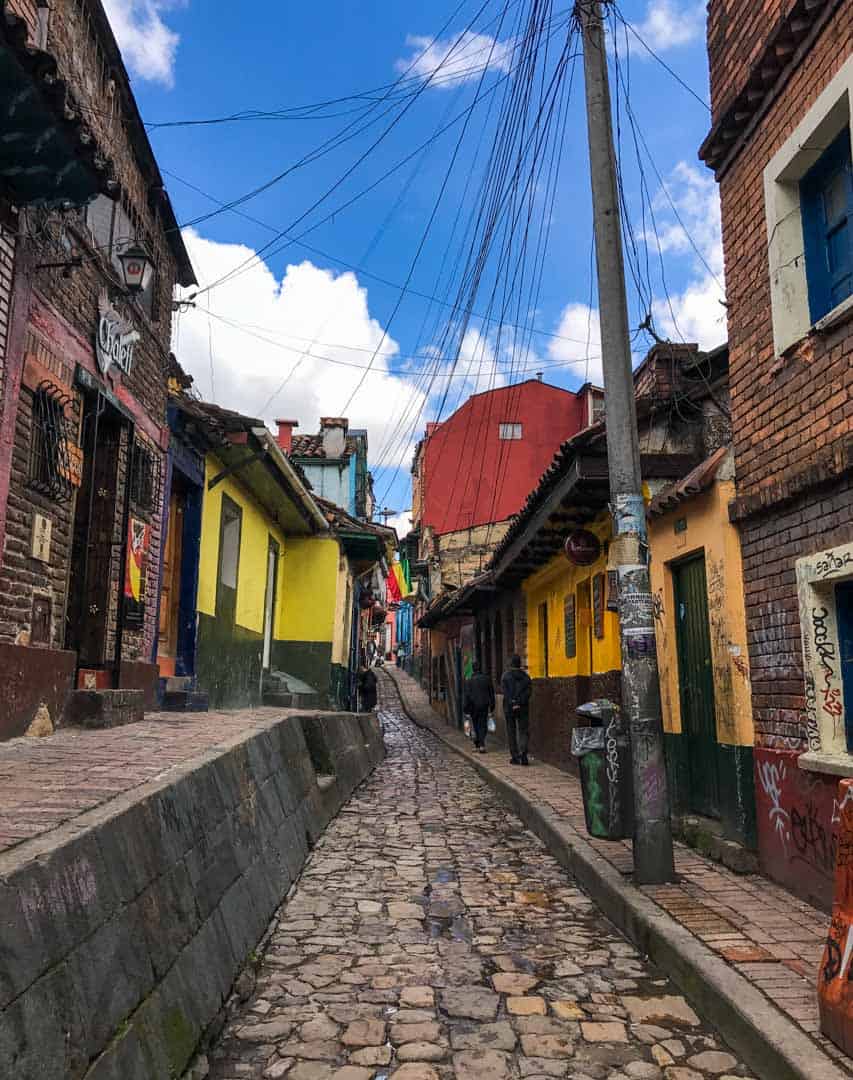
The alcoholic maize drink, originally brewed by the indigenous Muisca people, was a popular tipple in Bogotá right up until riots in 1948 led to its ban. It may be legal again today, but you won’t find it everywhere so if you’re game, drop by one of the chicherías here and have a taster.
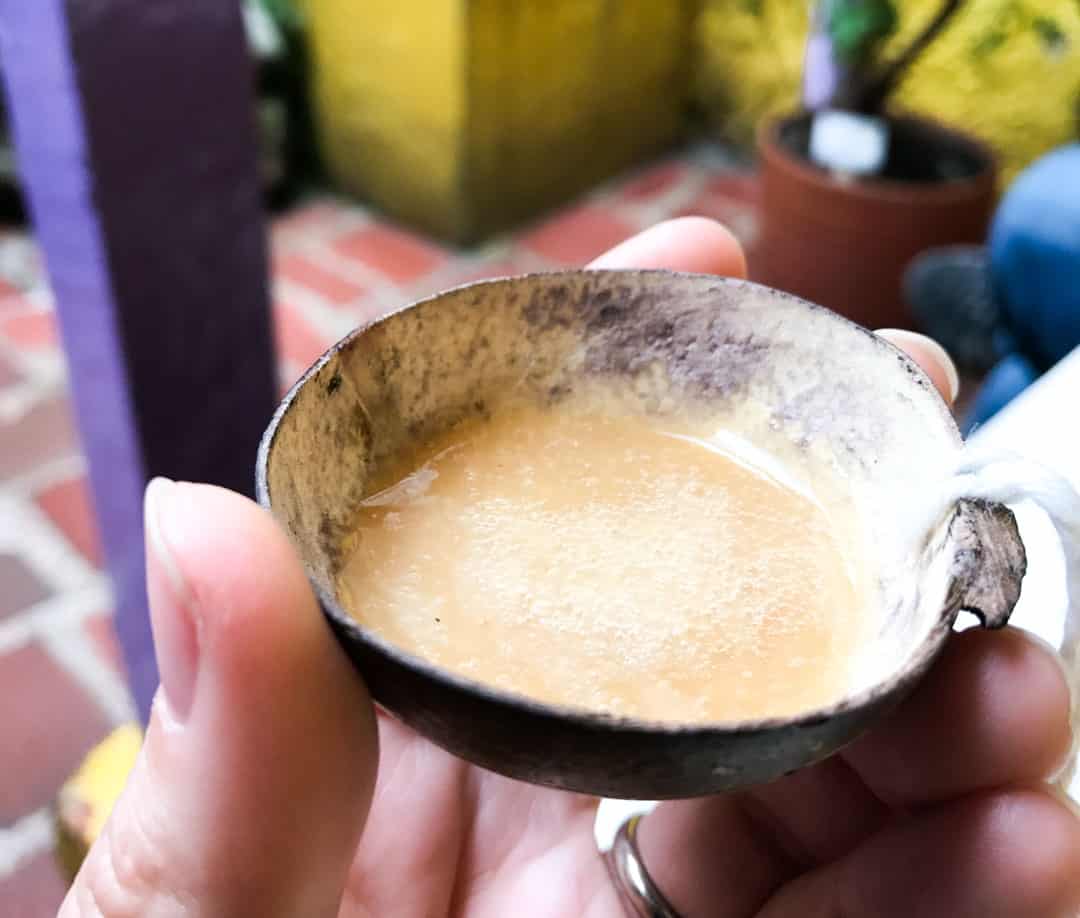
Follow Calle del Embudo to its end and you’ll pop out onto quirky Plaza del Chorro de Quevedo. This is said to be post-colonial Bogotá’s most historic spot: the site where the city of Bogotá was officially founded in 1538 by a Spanish conquistador named Gonzalo Jiménez de Quesada.
A walking tour is probably one of the best ways to navigate La Candelaria and its key landmarks: in addition to the history and culture tour we mentioned earlier, we’ve also heard great things about this Bogotá graffiti tour.
Bogotá safety: Like any big city, Bogotá has its fair share of street crime and scams targeting travellers.
The same rules apply that you would follow anywhere else: keep your wits about you and your personal belongings close, don’t carry valuables you can’t replace, have travel insurance, avoid wandering alone or after dark if you can, and always listen to your gut. Lonely Planet offers some good advice on staying safe in Bogotá.
Search out Colombian handicrafts at Usaquén Market
Colombian handicrafts are beautiful and make for excellent souvenirs and gifts. If you’re after a locally made memento or two while you’re visiting Bogotá, skip the tourist souvenir shops and make for a local flea market.
As Colombia’s capital, Bogotá is buzzing with markets offering all manner of wares, from arts and handicrafts to food and bric a brac, and this is especially true on a Sunday, so if you’re in town over a weekend, you’re in luck.
For a delightful local flea market in the suburbs north of the city, head to the Mercado de las Pulgas de Usaquén, or Usaquén Market.
Spread out along the cobbled streets skirting Usaquén Park, with a second section at the top of the hill above the carpark, this buzzing mercado serves up a great mix of locally made and sourced art, jewellery, handcrafted wares, antiques, coffee beans, food (including piles of delicious tropical fruit) and plenty more. There are cheaper markets to be found in Bogota, but you’ll find good quality here.
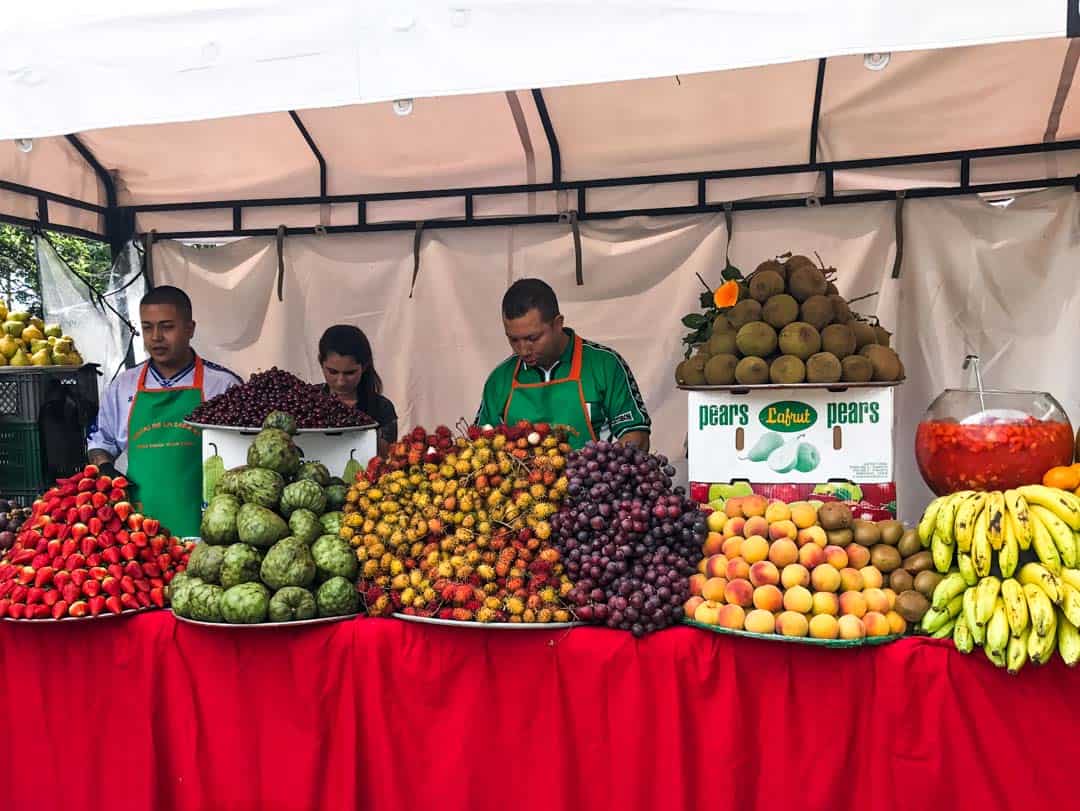
We picked up a couple of brightly-coloured Wayuu Mochila handbags woven by the tribal Wayuu women in the country’s north. You’ll spot these bags all over Colombia; they come in such a wide range of palettes that we saw guys as well as girls toting them, especially in Bogotá; they make an awesome, long-lasting gift for friends (or for yourself).
Despite being a suburb of Bogotá, Usaquén has something of a village-y charm that can make you forget you’re in a bustling metropolis. It’s also a bit of a foodie hub and you’ll find plenty of places to stop for a good Colombian coffee or a tasty meal (here’s what we had to say about the Caldo de Castillo we had at Usaquén restaurant Golconda).
To find the market, head to Parque de Usaquén on a Sunday. You can get to Usaquén from downtown Bogotá by TransMilenio bus or take an uber.
Does Bogotá have uber? Yes, it does exist in the city, we used it often and it was great: it took all the hassle out of negotiating fares with our basic Spanish and we didn’t have to worry about the negatives we’d heard regarding Colombian taxis.
Be aware though that uber is not yet officially endorsed in Bogotá so drivers are cautious about picking up or dropping off near taxi ranks or law enforcement. To this point, our first driver asked one of us to sit up front with him so he didn’t look like a taxi service; we made a point to do so from that point on.
Ponder the distinctive art and sculpture in Museo Botero
Chances are, you won’t travel far in Colombia without encountering at least one painting or sculpture by the country’s renowned figurative artist, Fernando Botero.
The prolific artist’s larger-than-life style can be seen dividing opinions in parks and galleries from Madrid and Singapore to Yerevan in Armenia to Medellín, the Colombian city of his birth.
But you’ll find one of the largest collection of his paintings and sculptures, donated by Botero himself, in a beautifully restored colonial mansion in La Candelaria, the historic heart of Bogotá.
A wander through the galleries of Bogotá’s Museo Botero (Botero Museum) is something of a window on life in Colombia, as seen through Botero’s eyes. His voluptuous sculptures and paintings are sometimes political, now and then historical, occasionally funny. Often, they are simple, serene still life scenes, albeit with a corpulent bent.
Make your own mind up about Botero with a visit to this tranquil (free) gallery and, if you decide his take on the world isn’t your thing, you can always search out the gallery’s other denizens of the art world: works by Picasso, Dalí, Matisse, Monet and other greats also hang here.
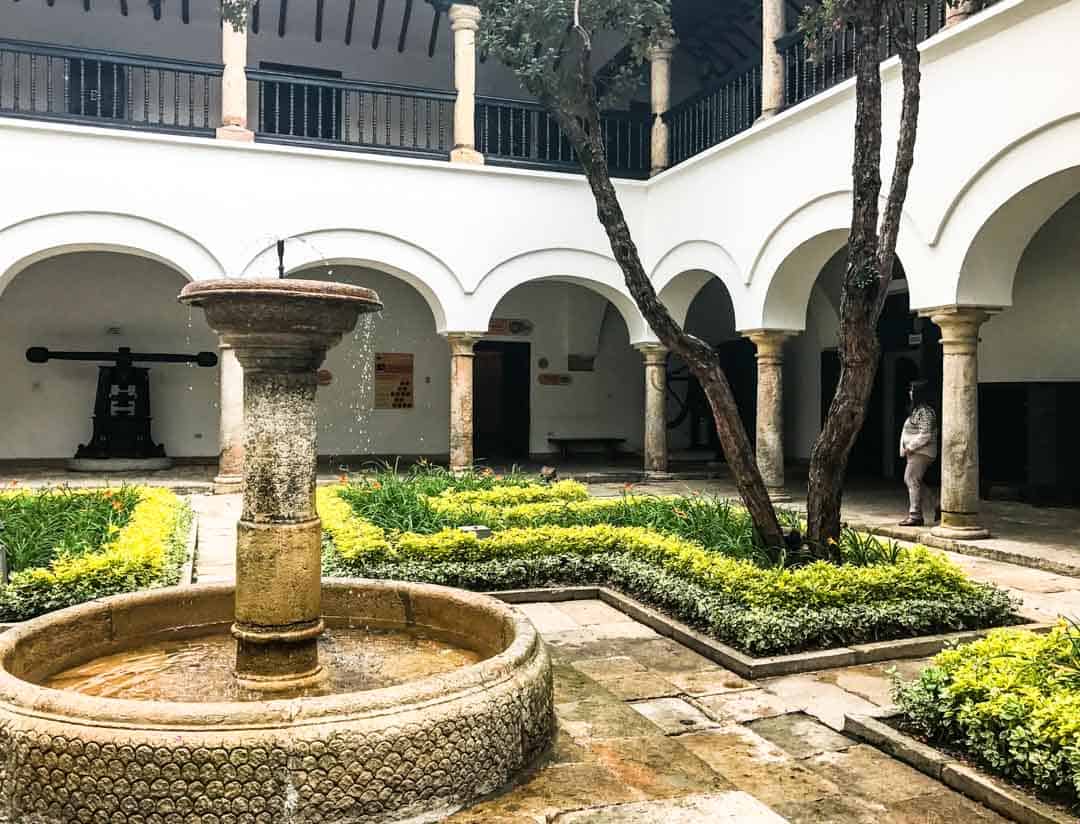
The Botero Museum is on Calle 11, No. 4-41 and is open every day except Tuesdays.
Want more Botero? If Botero wins you over and you’re heading to Medellín on your travels through Colombia, be sure to head to Botero Plaza in the Old Quarter; you’ll find 23 of his corpulent signature sculptures adorning the square there.
Feast your way through Bogotá with a check-list of traditional Colombian food
All that pavement pounding and highlights hunting in a new city is hungry work, and while traditional Colombian food may not be on your radar before you arrive, that will quickly change.
Colombian food, influenced as it is by highly diverse environmental, historical and cultural factors, has evolved with regional specialties and variations that often tell their own stories about the people, produce and practices of those places.
Bogotá might be the country’s capital, but it too has its own delicacies and takes on national dishes, from classics like tamales and hot chocolate with cheese (yes, you read that right), to hearty soups like milky Changua and soul-warming chicken-and-corn Ajiaco.
Where to eat in Bogotá is a serious question and one that warrants local advice as, depending on where you’re staying, every local will have their own recommendation.
A good start if you’re wandering La Candelaria though is La Puerta Falsa. It’s popular with tourists but this little hole-in-the-wall next to Bogotá Cathedral has been serving up Colombian classics for over 200 years, so they must be doing something right.
As for as what to eat, we’ve put together a tasty little post that gives you a heads-up on Colombian food and some of the traditional food you should definitely seek out while you’re there.
Do yourself a favour though, as soon as you arrive, stop by the first oblea stand you see, choose your wafer filling (sweet or savoury… or both) and kick off your Bogotá sightseeing with the city’s most quintessential on-the-go snack.
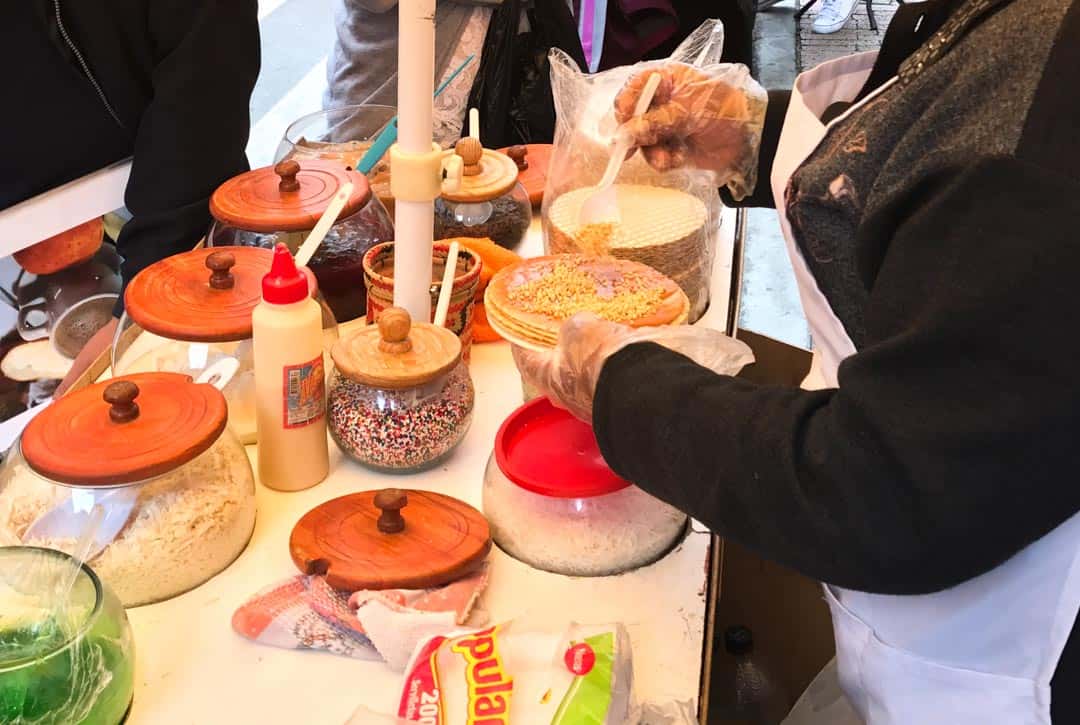
Crane your neck at the baroque beauty of Museo Santa Clara
Catholicism arrived in Bogotá with the Spanish in the 16th-century, and it wasn’t long before churches and chapels were being consecrated across the burgeoning colonial city.
Some of these early houses of worship survive today and still offer services, like the Iglesia di San Francisco, Bogotá’s oldest church.
If you choose to see just one house of worship while you’re in town though, make it Museo Santa Clara (Santa Clara Museum).
You could easily walk right past this austere-looking stone-and-brick building, with its rusty iron-barred windows. Except that it sits directly opposite the rear gardens of Bogotá’s Parliament building, so there’s a military check-point almost at the door.
Don’t be put off by either aspect (just tell the guards you’re visiting the museum), nor the fact that there is a very small entry fee of COP3,000 (around US$1). What awaits inside is absolutely worth it.
The Museo Santa Clara was built in 1647 as the Royal Convent of Santa Clara, a cloistered community of Franciscan nuns. The building is a classic example of OTT baroque design: from the wall-to-wall gilt-framed oil paintings, and the glittering floor-to-ceiling altarpiece, to the pleasing symmetry of the gilded floral motif barrel-vaulted ceiling. This is a small space with a lot to say.
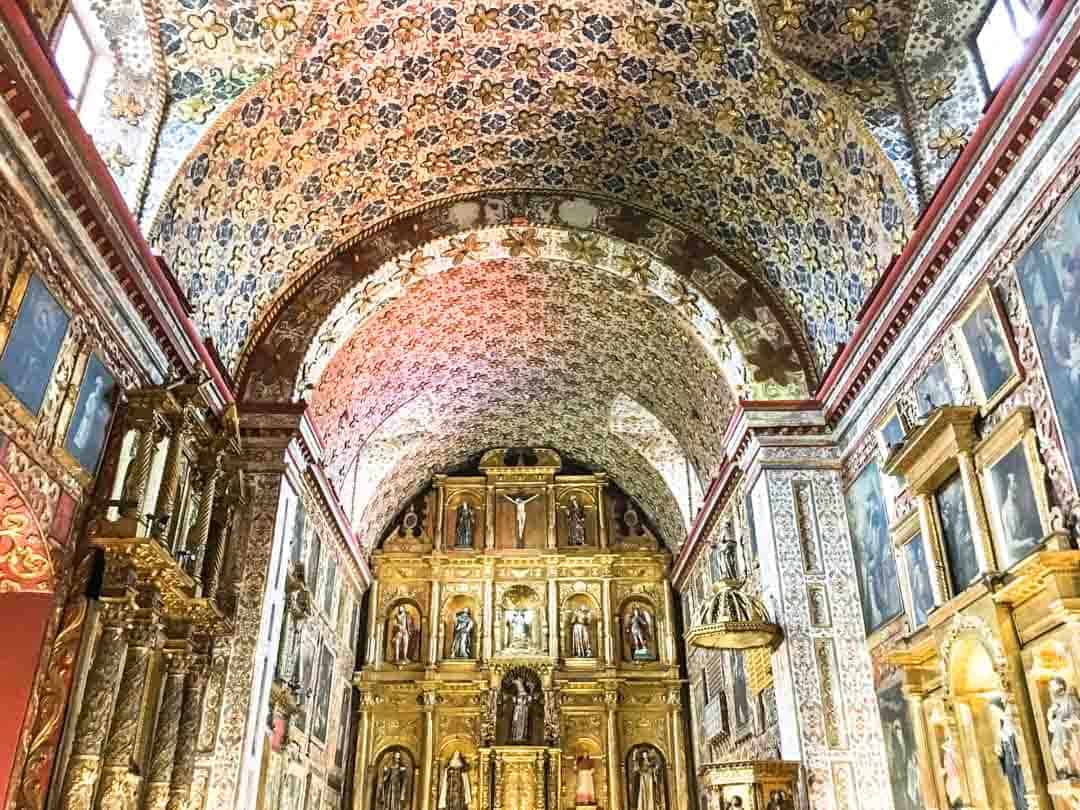
Santa Clara is no longer a church or a convent, but clues to the nuns’ secluded lives can still be found in features such as the dark, narrow tunnel with small alcoves that runs behind one wall of the decorated space. Here the nuns could attend confession, without ever being seen by the outside world.
The Museo Santa Clara Bogotá is closed on Mondays and is located on Carerra 8, #8-91.
Catch your breath on top of Mount Monserrate
No matter where you are in Bogotá, you’ll be aware of the constant – often mist-shrouded – presence of Mount Monserrate.
Ironically titled a hill by some, despite being a cool 3,152-metres above sea level, Monserrate has long been considered a sacred place: first by the indigenous Muisca people, and later by the Catholic church, which arranged for a small sanctuary to be built at the top of the mountain in the mid-17th century. The sanctuary continues to draw pilgrims today, and services are offered every day.
You can follow in the footsteps of the pilgrims, literally, and hike up to the top of Monserrate, a workout of around an hour or so (remember you’re at altitude too) along a path that’s open each morning, but closed in the afternoons and on Tuesdays.
Or you can save your legs and your breath and fast-track the climb by taking the funicular or the cable car. They run at different times, so work out your journey in advance.
At the top, you’ll find the sanctuary, restaurants and a souvenir market, as well as the number one reason for making the journey in the first place (unless you’re a pilgrim): the million dollar views over Bogotá’s vast cityscape.
That’s if the weather comes to the party. It didn’t for us, alas. Our takeout: if you have a sunny morning during your stay, get up that hill.
Daytrip from Bogotá to the underworld of Zipaquirá Salt Cathedral
You could easily cover our first nine activities over a busy 2 days in Bogotá, but with an extra day or two, we recommend getting out of the city for a daytrip to one of Colombia’s coolest off-beat destinations: the Zipaquirá Salt Cathedral.
The entrepreneurial Muisca people first started digging salt out of the halite mountains north of Bogotá some 2,000 years ago. Come the 20th-century and the mountains were still delivering, although by this stage, miners had been employing the modern extraction techniques that contributed to formation of the mine’s current tunnel network.
Given the significant risks of the job, miners first built a chapel inside Zipaquirá in 1932; a place where they could pray to their saints for protection.
Work on a first cathedral was started in the 1950s but was closed for safety reasons and later replaced by a new cathedral. Today, you can take a guided tour through a complex of small carved chapels (14 of them, representing the stations of the cross) before arriving at the majestic rock-cut cathedral itself, 200-metres underground.
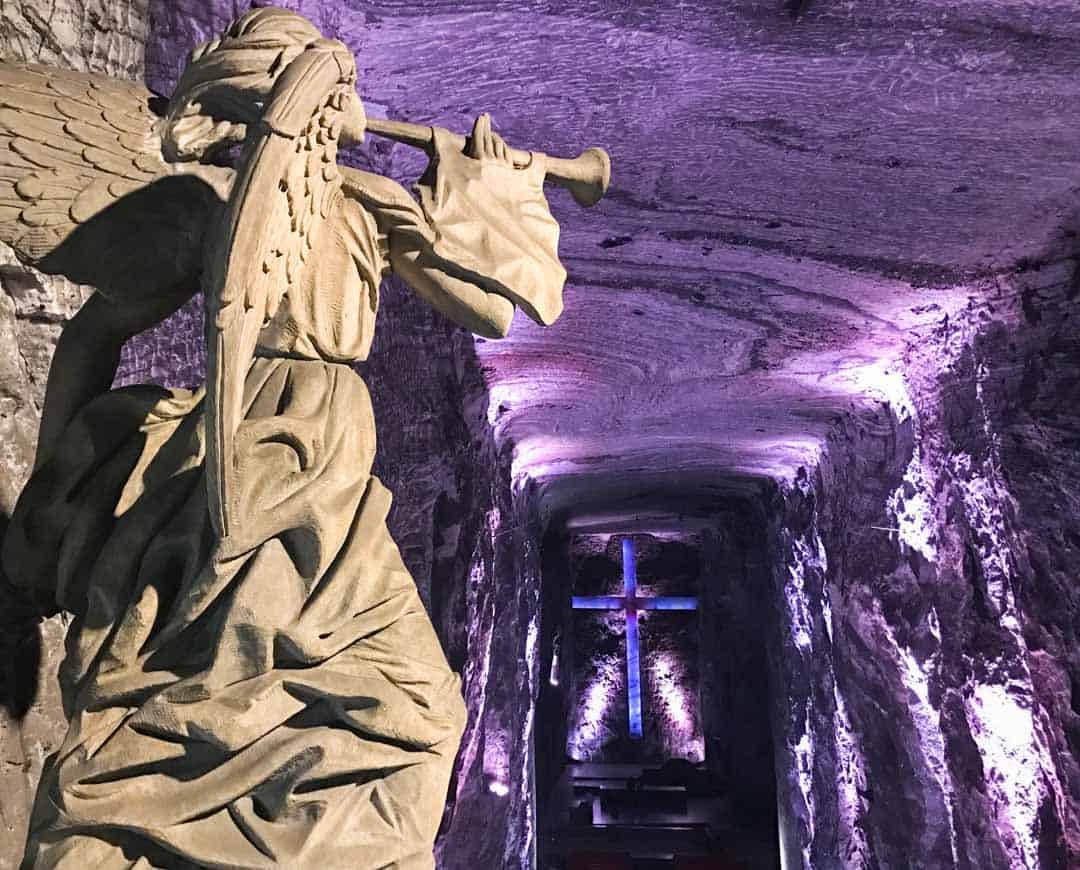
Despite its salty, subterranean nature, the Zipaquirá Salt Cathedral is a fully functioning church, so either head there on a Sunday and join the thousands of worshippers who attend Catholic services there that day. Or avoid at all costs and go on another day.
You could while away hours at Zipaquirá and check out the park’s other offerings (there’s a museum, a climbing wall, a light show and a stalls stocking every kind of salt souvenir you (n)ever wanted). Or you can do what we did and find a delicious Colombian lunch like this steaming bowl of Ajiaco, which we savoured in the nearby town of Cajica.
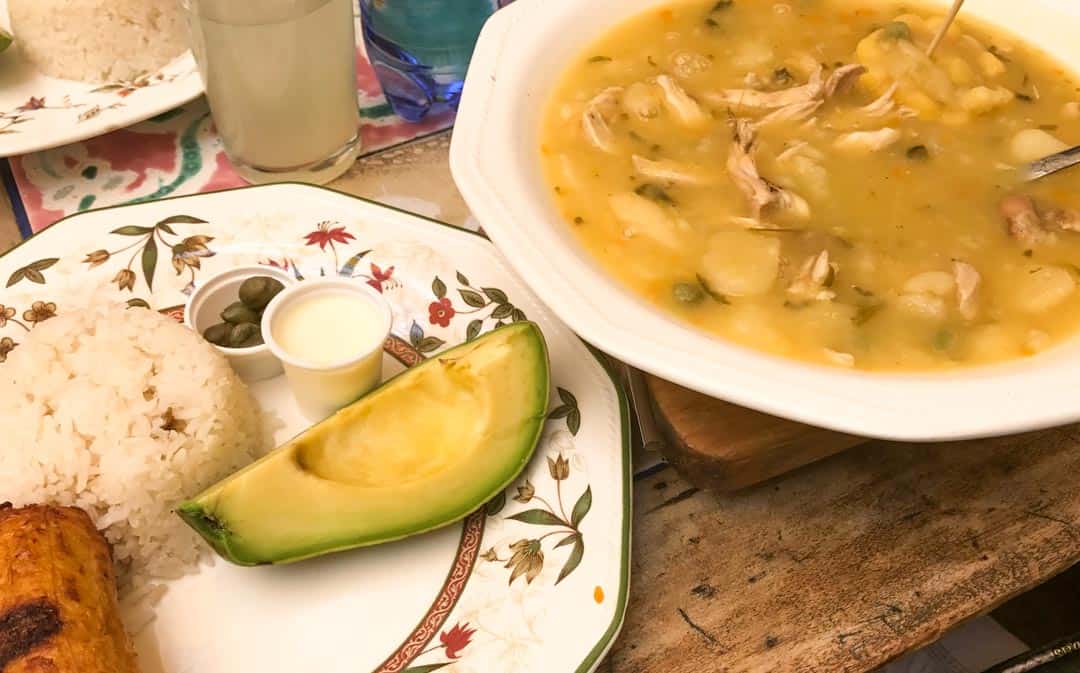
Zipaquirá Salt Cathedral is about an hour by car north of Bogotá. You can catch a bus there from the Porta del Norte bus terminal in Bogotá. Or, if you have the time, you can make a day of it and take a scenic train ride. It’s a 3-hour journey each way, with an hour at the salt cathedral and time for lunch, but you’ll avoid Bogotá’s traffic and can sit back and enjoy the picturesque Colombian countryside.
Got a question or comment? Drop us a message below. For more South America experiences and itineraries, check out our South America page.

Hi Dan, thanks for this super post, it’s full of great advice! Looks like you’ve done a really goood research before visiting Bogota!. By any chance, have you done this” Heroes Tour” in Bogota? http://heroestourbogota.com
I found them in Lonely Planet, https://lonelyplanet.com/colombia/bogota/activities/a/poi-act/363308. It’s looks pretty cool, but I’ve seen much about it online, as I am preparing my travel to Bogota in January! I hope you could help ?
Hi Anna, thanks so much, we’re really pleased you’ve found the post helpful! We joined Beyond Colombia for our walking tour of Bogota, and our guide was excellent. Heroes looks great too though, really good reviews online! Whichever company you choose for a walking tour, it’s so worth doing. We hope you have a really fantastic time in Bogota, it’s an awesome city!